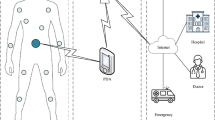Abstract
The recent research in Body Area Networks (BANs) is focused on making its communication more reliable, energy efficient, secure, and to better utilize system resources. In this paper we propose a novel BAN architecture for indoor hospital environments, and a new mechanism of peer discovery with routing table construction that helps to reduce network traffic load, energy consumption, and improves BAN reliability. The three scenarios with fixed and variable number of packets sent by source nodes are considered for better analysis. Static nodes are considered in first and second scenarios whereas mobile nodes are used in third scenario. We have performed extensive simulations in the OMNeT++ based Castalia-3.2 simulation environment to show that our proposed protocol has better performance in terms of reduced BAN traffic load, increased successful transmission rate, reduced number of packets forwarded by intermediate nodes, no packets dropped due to buffer overflow, and overall lower energy consumption when compared with a similar protocols.















Similar content being viewed by others
Explore related subjects
Discover the latest articles, news and stories from top researchers in related subjects.References
Agarwal S, Divya, Pandey GN (2010) SVM based context awareness using body area sensor network for pervasive healthcare monitoring. In: Proceedings of the First International Conference on Intelligent Interactive Technologies and multimedia (IITM ‘10), Allahabad, India
Amoretti M, Copelli S, Wientapper F, Furfari F, Lenzi S, Chessa S (2013) Sensor data fusion for activity monitoring in the PERSONA ambient assisted living project. J Ambient Intell Human Comput 4(1):67–84
Antón P, Munoz A, Mana A, Koshutanski H (2012) Security-enhanced ambient assisted living supporting school activities during hospitalisation. J Ambient Intell Human Comput 3(3):177–192
Chen M, Kwon T, Choi Y (2006) Energy-efficient differentiated directed diffusion (EDDD) for real-time traffic in wireless sensor networks. Elsevier Comput Commun 29(2):231–245
Chen M, Leung V, Mao S, Yuan Y (2007) Directional geographical routing for real-time video communications in wireless sensor networks. Comput Commun (JCC) 30(17):3368–3383
Chen M, Kwon T, Mao S, Yuan Y, Leung V (2008) Reliable and energy-efficient routing protocol in dense wireless sensor networks. Int J Sensor Netw 4(1/2):104–117
Chen M, Leung V, Mao S, Xiao Y, Chlamtac I (2009) Hybrid geographical routing for flexible energy-delay trade-offs. IEEE Trans Veh Technol 58(9):4976–4988
Chen M, Gonzalez S, Vasilakos A, Cao H, Leung VCM (2010) Body area networks: a survey. ACM/Springer Mobile Networks and Applications (MONET) 16(2):171–193
Curtis D, Shih E, Waterman J, Guttag J, Bailey J, Stair T, Ohno-Machado L (2008) Physiological signal monitoring in the waiting areas of an emergency room. In: Proceedings of the ICST 3rd international conference on Body area networks (BodyNets ‘08), Arizona, USA
Felemban E, Lee CG, Ekici E (2006) MMSPEED: multipath multi-SPEED protocol for QoS guarantee of reliability and timeliness in wireless sensor networks. IEEE Trans Mobile Comput 5(6):738–754
Gao T, Massey T, Selavo L, Crawford D, Chen B-r, Lorincz K, Welsh M (2007) The advanced health and disaster aid network: a light-weight wireless medical system for triage. IEEE Trans Biomed Circuits Syst 1(3):203–216
Huang X, Fang Y (2008) Multiconstrained QoS multipath routing in wireless sensor networks. Wirel Netw 14(4):465–478
IEEE, 8. T. (2007, November) IEEE 802.15 WPAN™ Task Group 6 (TG6) Body Area Networks. (IEEE standards) Retrieved 20 Nov 2012. http://www.ieee802.org/15/pub/TG6.html
Jiang S, Cao Y, Lyengar S, Kuryloski P, Jafari R, Xue Y, Wicker S (2008) CareNet: an integrated wireless sensor networking environment for remote healthcare. In: Proceedings of ICST 3rd international conference on body area networks (BodyNets ‘08), Tempe, Arizona, USA
Kim D-Y, Cho J (2009) WBAN meets WBAN: smart mobile space over wireless body area networks. In: IEEE 70th Vehicular Technology Conference Fall (VTC 2009-Fall), Anchorage, Alaska, USA
Ko J, Lu C, Srivastava M, Stankovic J, Terzis A, Welsh M (2010) Wireless sensor networks for healthcare. Proc IEEE 98(11):1947–1960
Liang X, Balasingham I, Byun S-S (2008) A reinforcement learning based routing protocol with QoS support for biomedical sensor networks. In: First International Symposium on Applied Sciences on Biomedical and Communication Technologies, 2008. ISABEL ‘08, Aalborg, Denmark
NICTA (2011, March) Castalia. (National ICT Australia) Retrieved 28 Sept 2012. http://castalia.npc.nicta.com.au
Razzaque M, Alam M, Rashid M, Hong C (2008) Multi-constrained QoS geographic routing for heterogeneous traffic in sensor networks. In: The 5th IEEE Consumer Communications and Networking Conference (CCNC 2008), pp 2589–2601, Kyung Hee University, Seoul
Razzaque MA, Hong CS, Lee S (2011) Data-centric Multiobjective QoS-aware routing protocol for body sensor networks. Sensors 11(1):917–937
Ugolotti R, Sassi F, Mordonini M, Cagnoni S (2013) Multi-sensor system for detection and classification of human activities. J Ambient Intell Human Comput 4(1):27–41
Wood A, Virone G, Doan T, Cao Q, Selavo L, Wu Y, Stankovic J (2006) ALARM-NET: wireless sensor networks for assisted-living and residential monitoring. Department of Computer Science, University of Virginia, Virgina
Xu J, Liu W, Lang F, Zhang Y, Wang C (2010) Distance measurement model based on RSSI in WSN. Wirel Sens Netw 2(8):606–611. doi:10.4236/wsn.2010.28072
Zhen B, Patel M, Lee S, Won ET, Astrin A (2011) 15-08-0644-09-0006-tg6-technical-requirements (IEEE Project: IEEE P802.15 Working Group for Wireless Personal Area Networks (WPANs)). Retrieved 28 Sept 2012, from IEEE: http://mentor.ieee.org/802.15/dcn/11/15-11-0307-00-0006-tg6-closing-report-march-2011.ppt
Author information
Authors and Affiliations
Corresponding author
Rights and permissions
About this article
Cite this article
Khan, Z.A., Sivakumar, S., Phillips, W. et al. A new patient monitoring framework and Energy-aware Peering Routing Protocol (EPR) for Body Area Network communication. J Ambient Intell Human Comput 5, 409–423 (2014). https://doi.org/10.1007/s12652-013-0195-6
Received:
Accepted:
Published:
Issue Date:
DOI: https://doi.org/10.1007/s12652-013-0195-6




